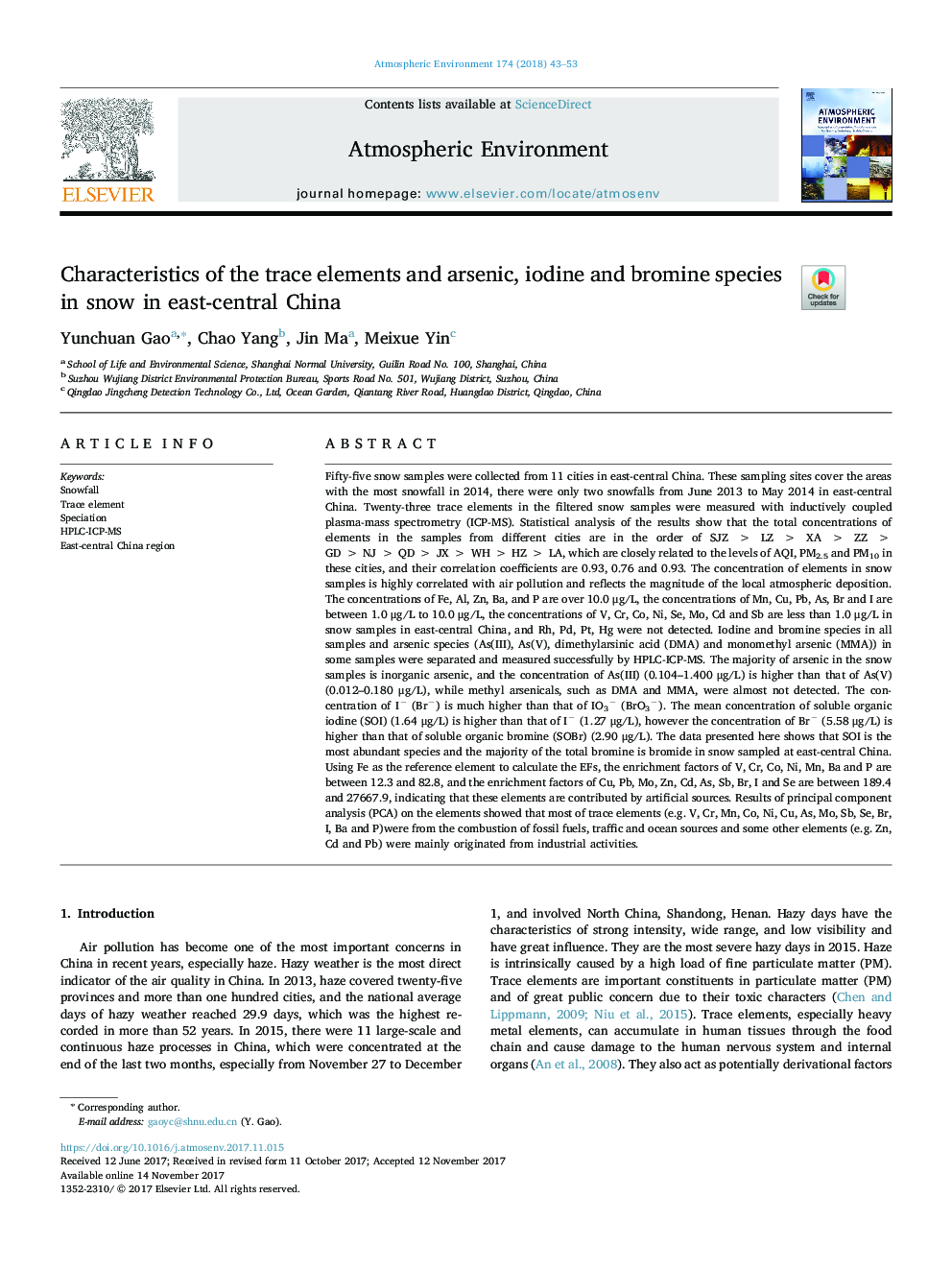| کد مقاله | کد نشریه | سال انتشار | مقاله انگلیسی | نسخه تمام متن |
|---|---|---|---|---|
| 8864206 | 1620300 | 2018 | 11 صفحه PDF | دانلود رایگان |
عنوان انگلیسی مقاله ISI
Characteristics of the trace elements and arsenic, iodine and bromine species in snow in east-central China
ترجمه فارسی عنوان
ویژگی های عناصر ریز و آرسنیک، گونه ید و بروم در برف در شرق و مرکز چین
دانلود مقاله + سفارش ترجمه
دانلود مقاله ISI انگلیسی
رایگان برای ایرانیان
موضوعات مرتبط
مهندسی و علوم پایه
علوم زمین و سیارات
علم هواشناسی
چکیده انگلیسی
Fifty-five snow samples were collected from 11 cities in east-central China. These sampling sites cover the areas with the most snowfall in 2014, there were only two snowfalls from June 2013 to May 2014 in east-central China. Twenty-three trace elements in the filtered snow samples were measured with inductively coupled plasma-mass spectrometry (ICP-MS). Statistical analysis of the results show that the total concentrations of elements in the samples from different cities are in the order of SJZ > LZ > XA > ZZ > GD > NJ > QD > JX > WH > HZ > LA, which are closely related to the levels of AQI, PM2.5 and PM10 in these cities, and their correlation coefficients are 0.93, 0.76 and 0.93. The concentration of elements in snow samples is highly correlated with air pollution and reflects the magnitude of the local atmospheric deposition. The concentrations of Fe, Al, Zn, Ba, and P are over 10.0 μg/L, the concentrations of Mn, Cu, Pb, As, Br and I are between 1.0 μg/L to 10.0 μg/L, the concentrations of V, Cr, Co, Ni, Se, Mo, Cd and Sb are less than 1.0 μg/L in snow samples in east-central China, and Rh, Pd, Pt, Hg were not detected. Iodine and bromine species in all samples and arsenic species (As(III), As(V), dimethylarsinic acid (DMA) and monomethyl arsenic (MMA)) in some samples were separated and measured successfully by HPLC-ICP-MS. The majority of arsenic in the snow samples is inorganic arsenic, and the concentration of As(III) (0.104-1.400 μg/L) is higher than that of As(V) (0.012-0.180 μg/L), while methyl arsenicals, such as DMA and MMA, were almost not detected. The concentration of Iâ (Brâ) is much higher than that of IO3â (BrO3â). The mean concentration of soluble organic iodine (SOI) (1.64 μg/L) is higher than that of Iâ (1.27 μg/L), however the concentration of Brâ (5.58 μg/L) is higher than that of soluble organic bromine (SOBr) (2.90 μg/L). The data presented here shows that SOI is the most abundant species and the majority of the total bromine is bromide in snow sampled at east-central China. Using Fe as the reference element to calculate the EFs, the enrichment factors of V, Cr, Co, Ni, Mn, Ba and P are between 12.3 and 82.8, and the enrichment factors of Cu, Pb, Mo, Zn, Cd, As, Sb, Br, I and Se are between 189.4 and 27667.9, indicating that these elements are contributed by artificial sources. Results of principal component analysis (PCA) on the elements showed that most of trace elements (e.g. V, Cr, Mn, Co, Ni, Cu, As, Mo, Sb, Se, Br, I, Ba and P)were from the combustion of fossil fuels, traffic and ocean sources and some other elements (e.g. Zn, Cd and Pb) were mainly originated from industrial activities.
ناشر
Database: Elsevier - ScienceDirect (ساینس دایرکت)
Journal: Atmospheric Environment - Volume 174, February 2018, Pages 43-53
Journal: Atmospheric Environment - Volume 174, February 2018, Pages 43-53
نویسندگان
Yunchuan Gao, Chao Yang, Jin Ma, Meixue Yin,
